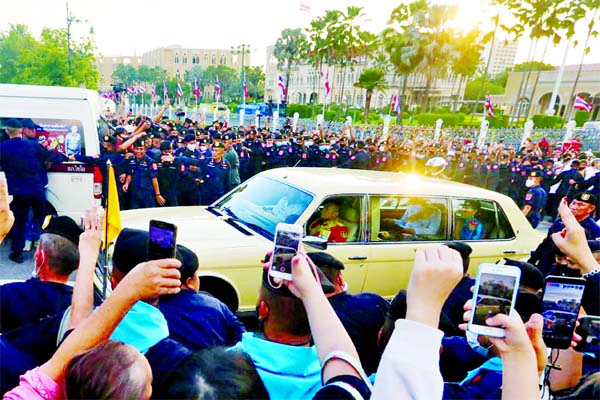
A defining moment in Thailand’s growing protest movement started with the unannounced arrival of a champagne-coloured Rolls Royce stretch limousine on a Bangkok street.
When Queen Suthida’s motorcade slowed as it encountered a few dozen protesters jeering outside Bangkok’s Government House on Oct. 14, royalists denounced it as unforgivable harassment in a kingdom whose constitution demands reverence for the monarchy.
The government, led by a former army chief who was the initial target of months of protests, responded swiftly.
It banned protests and made dozens of arrests. But that spurred more demonstrations – and much greater criticism of a monarchy that protesters say has helped to enable decades of military domination.
At a time when King Maha Vajiralongkorn has faced unprecedented scrutiny, many Thais have questioned why the queen was on that road at that time, and have challenged the severity of the reaction – which also included three arrests on little-used charges that could carry the death penalty.
The opposition Move Forward party said on Thursday it planned a parliamentary motion “to study the mistakes made over the motorcade”, complaining this had led to severe action being taken, specifically citing the use of Article 110 charges of violence or attempted violence against the queen.
“It shows a failure in the setting of the royal motorcade route,” said party spokesman Wiroj Lakkhanaadisorn.
Other people noted the route was not the shortest between the Dusit Palace, where the king and queen reside, and the temple where Suthida was going.
They also asked why the motorcade had moved so slowly, even at points where there was no evident obstruction. Royal vehicles usually move much faster.
Some Thais have raised questions whether the encounter was used to justify a crackdown. Reuters has no evidence to confirm this.
The Palace declined comment, as it has since the start of three months of protests that at first called for the removal of Prime Minister Prayuth Chan-ocha, a former army chief, but then broke a decades-old taboo by demanding royal reform.
Government spokesman Anucha Burapachaisri told Reuters that securing royal motorcade routes was the police’s responsibility.
“The emergency declaration was necessary to prevent other incidents and conflicts,” he said, rejecting protesters’ accusations that it was a provocation to justify harsh measures. Police did not respond to repeated Reuters requests for comment.
Reuters has reviewed nine videos supplied by the people who shot them and taken from different angles in addition to other video on social media, well over 100 still pictures with accompanying metadata and interviewed eight eyewitnesses to reconstruct how events unfolded.
There are gaps. Reuters was unable to establish the full route of the motorcade before and after the incident, why it was taken, why there had been no advance notice of the route or why the royal convoy travelled much more slowly than usual.
The incident started when Queen Suthida reached the protesters at around 5:22 pm on Oct. 14.
Suthida was on a rare visit from Europe, where she and the king had spent nearly the entire year before arriving in Bangkok on Oct. 10.
Dressed in a light blue silk dress with a gold sash, she was travelling on royal duties with the king’s 15-year-old son, and potential heir, Dipangkorn Rasmijoti, who wore his white dress uniform, replete with gold braid.
The protesters were outside Prayuth’s office at Government House. Prayuth seized power in a 2014 coup and protesters accuse him of engineering an election last year to keep his hold – an accusation he denies.

